Cuba surprised me at every turn. I love trips that shift my world view and this was definitely one of them. But, if there is one thing that I learned in Cuba, it is that there is not a single truth. What surprised us may not surprise you at all!
I love sharing our family’s experiences with you, but the purpose of our stories is not to have you import our perceptions. We hope to inspire you to take your kids and have your own experiences. The way we best help our children to become global citizens is to provide them with enough complex, unique views of the world that they aren’t taken off guard the way I was by Cuba. Fascinated, enthralled, inspired? Yes. Surprised? No.
1. People are living great lives
The Cuban people are resilient, creative, and fully alive! Maybe this shouldn’t be surprising, but the media message that I’ve received over the years (and the message from many of the books I read) has focused on the idea that people are suffering under a communist state. It is more complicated than saying that everyone is doing fine. We are starting to share personal profiles of our new acquaintances and other stories.
I want to focus on these messages for now, all of the people we met in Cuba:
- had their basic needs met (more than the residents of cities I’ve called home)
- enjoyed lively communities of friends and family (more connected than any neighborhood I’ve lived in)
- led fulfilling lives (I suppose any comparisons are up for interpretation)
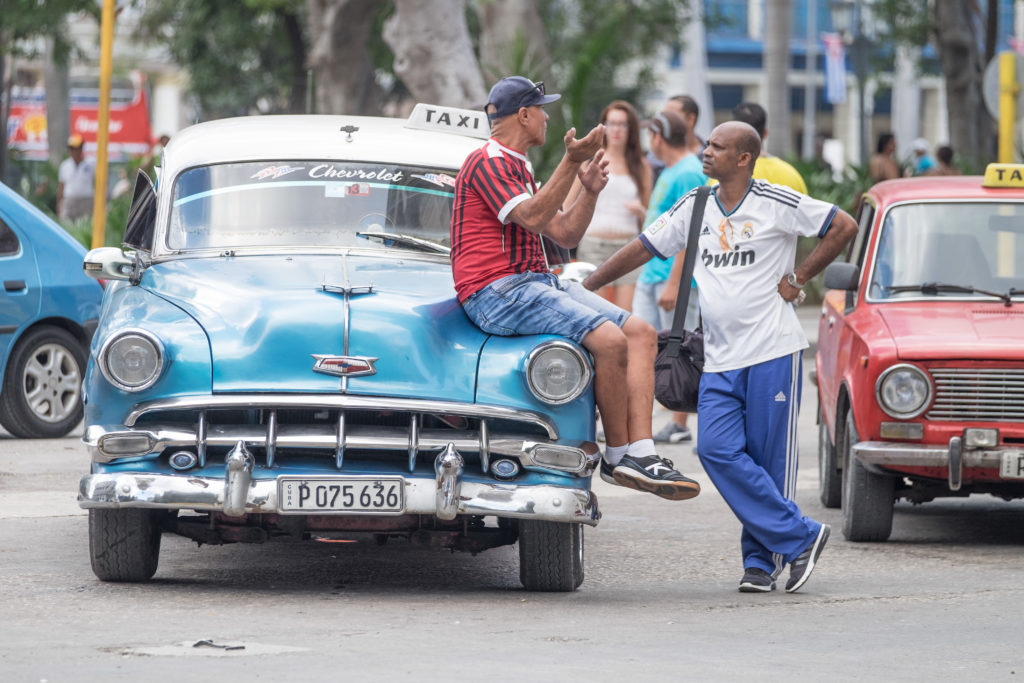
Everywhere we went we saw people taking time to connect with one another.
2. Boatloads of tourists
Literally. Cruise ships docking in the Port of Havana bring upwards of 4000 people per day to the city. Being in Old Havana felt like a tidal wave of camera-wielding, rum-seeking, non-Spanish speakers was breaking over my head. To be fair, we mostly fall into that category too and we did choose to go during high tourist season, but wow.
Early morning and late evening were great times to wander around the old town area. We were happiest when we got off the beaten path a bit more. For example, staying on Carlos (“El Cowboy”) and Amarilis’ mini-farm in Viñales was quiet and provided great opportunities to connect. Connie and Guy, our lovely Seattle friends, rented a car (see more on how to do this here) and we had a couple great days wandering through smaller towns like Camajuaní and Remidios. We drove the causeway Pedroplén a Cayo Santa María. Our group ventured (on roads) into the jungle of the Escambray mountains.
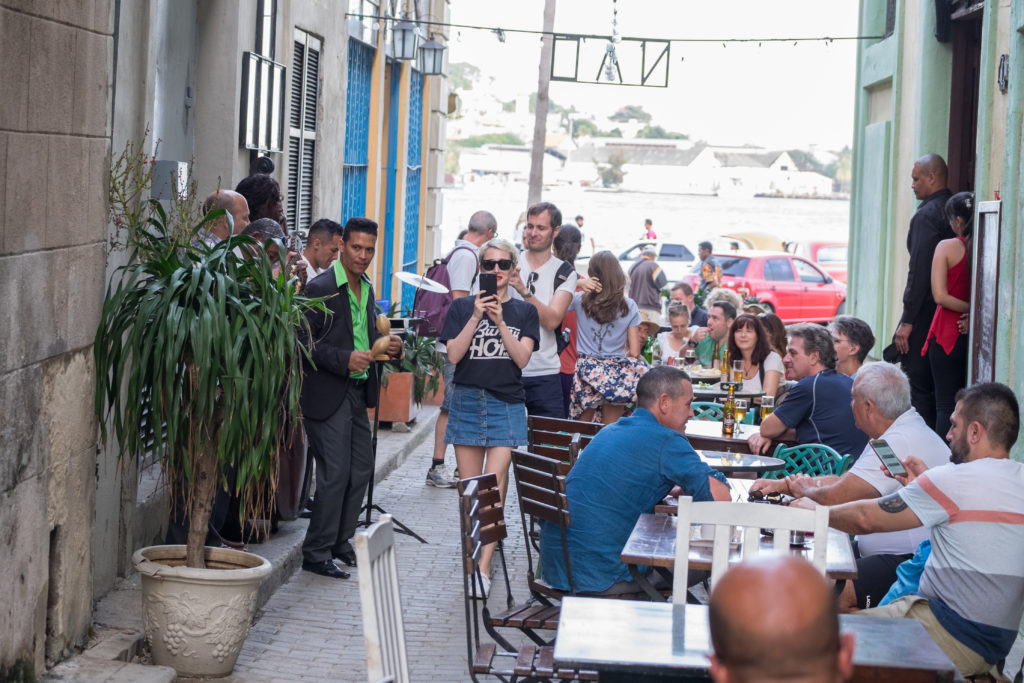
Restaurant on a side street in Havana. In the background you can see the harbor. Just to the right, out of sight, is a massive cruise ship.
3. No ads, just government billboards
No one is trying to sell you anything but commitment to Cuba, loyalty to the revolution and its leaders, and other government-sanctioned suggestions. It was lovely not to be visually pressured to drink the non-Coke cola, visit certain restaurants, or eat TV dinners. We did get a steady influx of messages like ‘Patria o Muerte’ (Country or Death), ‘Hacer del Trabajo la Meta Para Vencer’ (Make Work the Goal to Reach), ‘Gracias para todo, Fidel’ (Thank you for everything, Fidel). I really enjoyed the propaganda. It felt positive and empowering. As a professional proponent of good government, I think our government could benefit from telling people a little more about the good things it is doing.
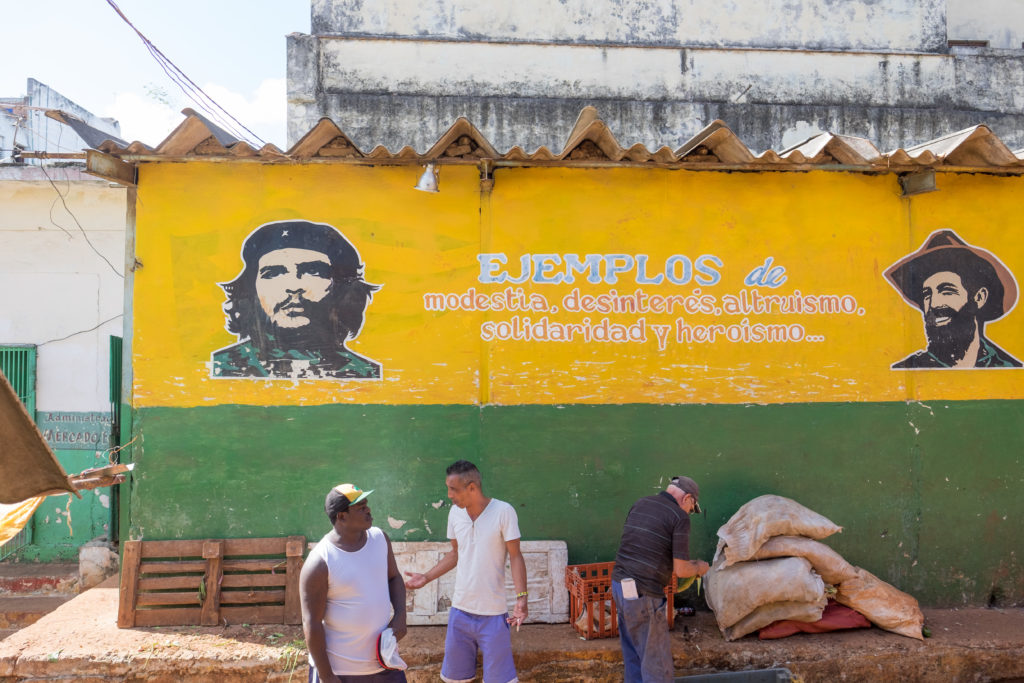
Che Guevara and Camillo Cienfuegos, two revolutionary heroes, encourage you to be like them: examples of modesty, with a lack of self-interest, altruistic, have solidarity, and heroism.
4. Almost no homelessness
I work in downtown Seattle and I see more human suffering, poverty, and need on my way from the bus to my office than I saw in our whole time in Cuba. Maybe it is heavy government subsidies of housing, the many Communist-style cement apartment blocks, or the tight-knit family communities that I mentioned above, but something is working. It may be that instead of homelessness, there are crowding issues. Meiby (say “maybe”), a singer we met, lived with her sister, mother, aunt, and grandmother along with several children. My bet is that living with four generations to a house is preferable to having no house.
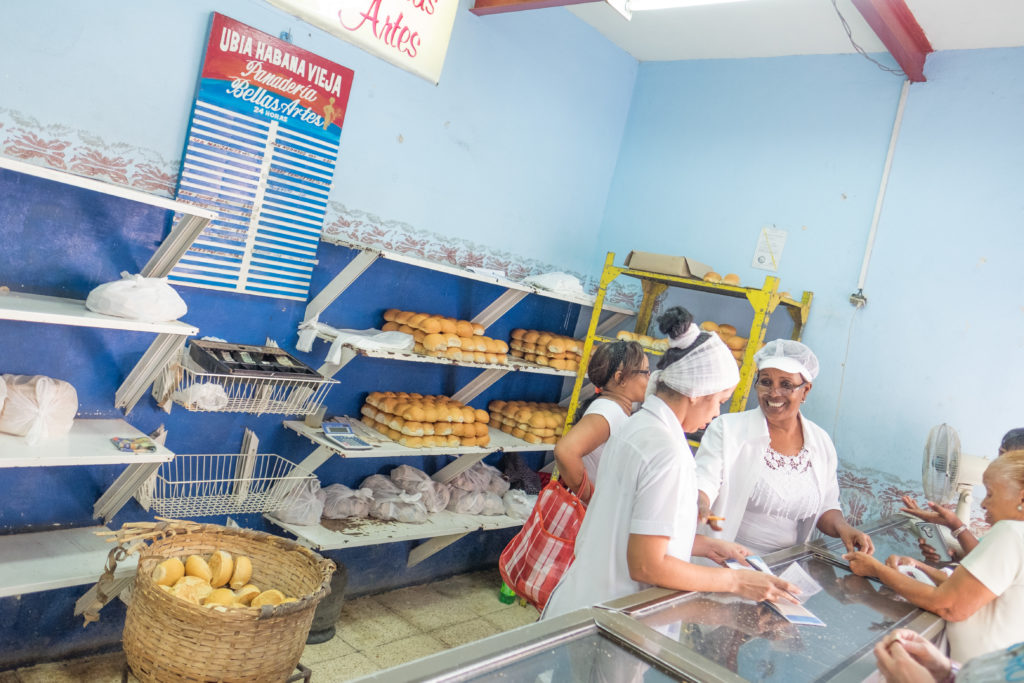
This is less a photo about homelessness and more about food security, but it is based in the same core value of socialism: care for all. These women are giving free bread and marking the customers’ ration cards.
5. Dearth of snacks
Think you’ll stop into the corner store for a small packaged item like a bag of nuts or some crackers to tide the kids over until a late dinner? Nope. No obvious corner stores or snacky places. What I did see: fresh produce markets, butcher shops, a grocery with the building blocks for scratch-meals (condensed milk, rice, sardines, olives, tomato sauce, etc.), bakeries (mostly loaves of bread), water/soda/rum stores. Exceptions to this rule are gas stations and truck stops. They were more likely to have a small selection of packaged items.
We solved this problem in many ways. Paper rolled peanuts (mani) from the old maniceros who seemed to be in each town. Ice cream at mobile carts and bananas at the produce market. And when desperate, we got a filling drink like a piña colada sin (without) alcohol—or con (with) alcohol depending on how the grownups were feeling or another sweet shot of espresso (maybe not the go-to for kids, but Beija liked it). Next time I might bring more bags of nuts or protein bars from home.
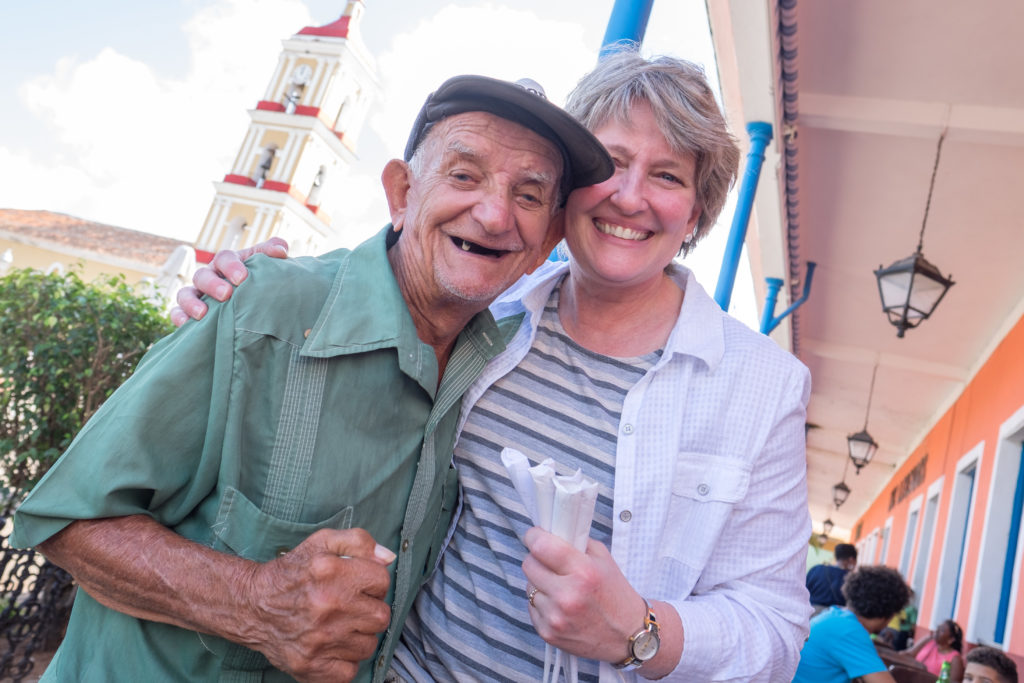
Here is our dear friend Connie buying six rolls of peanuts from Manuel for CUC$1. Snacks for us, a little income for Manuel who was super-sweet and fun to talk to.
6. Menus are essentially the same
With a few notable exceptions, in the region we visited, restaurant menus were almost interchangeable. Sautéed shrimp, sautéed lobster, pork (steaks or pulled), beef (steaks or pulled) and each comes with Moros y Christianos (black beans and rice, or literally Muslims and Christians); a salad of tomato, cabbage, and cucumber; and malanga (a starchy tuber). I was pretty happy with the options and the addition of the occasional fried plantains and a mojito. Beija was completely satisfied with these choices. In fact, she started up a daily lobster habit that has come to an abrupt halt with our return home.
I was able to get one of our hosts, Amaryllis, to let me fry up shaved burro platanos (a type of green plantain) in the kitchen—she watched me like a hawk—and she generously shared her recipes for flan (which she served us for breakfast) and limonada. When I can test them out and put actual measurements to her “a little of this and a little of that” explanations I’ll share them with you (here is the flan!). Watch for the delicious “comida de Amarilis!”
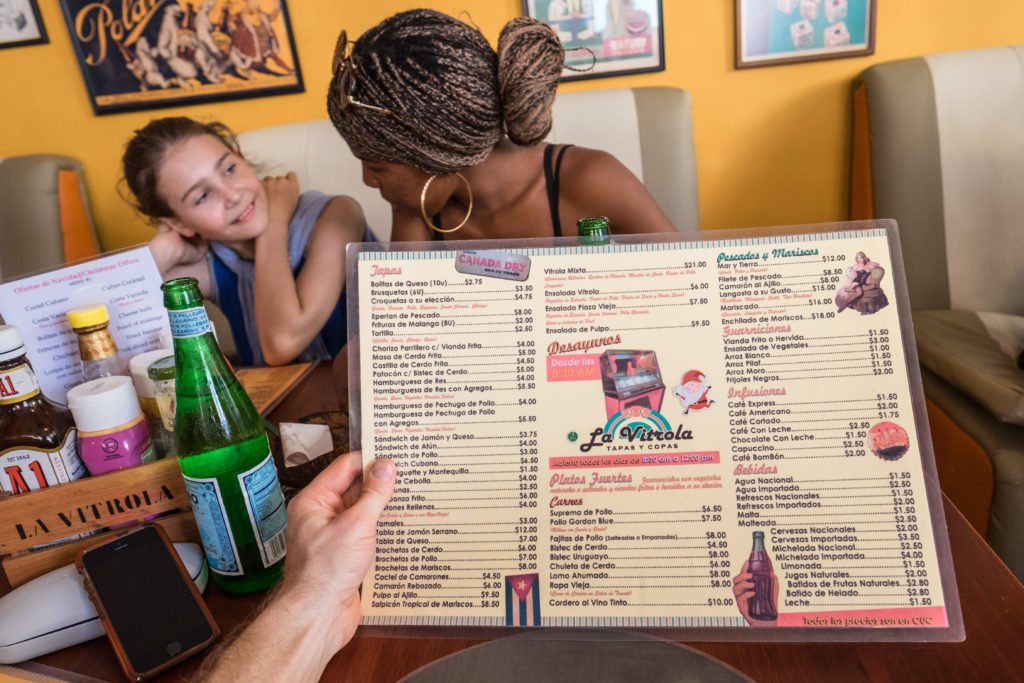
Dining at La Vitrola with our guide Meiby. This menu actually had a couple of different things on it now that I have claimed that the menus are all the same. I recommend the Tostones Rellenos.
7. Lots of phones but rare, impenetrable internet
Cell phones in Cuba are very common. You’ll see taxi drivers, people on horses, and bicyclists all answering their phones “dime” (dee-may, tell me). But, coming from someone who feels put out when there isn’t working wifi on the bus, internet is hard to make happen. I do appreciate the idea of a vacation technology detox, but how are we supposed to put adorable photos on Facebook when there is no accessible internet?! Jay has a detailed post planned on how to get internet in Cuba, so watch for that. I always found it both hilarious and triggering of my internet addiction when we turned a corner and saw the telltale sign of wifi: a hundred people staring intently at their screens.
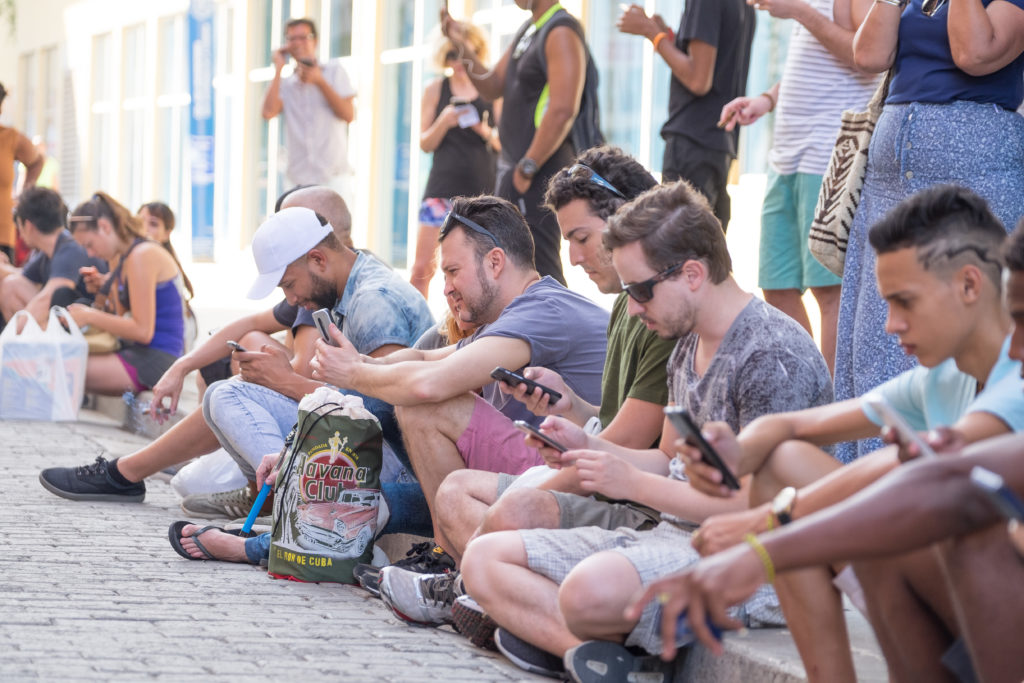
Need a little screen time?
Have you visited Cuba? What surprised you the most? Have questions?
Thanks for taking time to write this! Can’t wait to hear more. The first point is the best…
Of course it is! 🙂
Kymber, I am just a little Celoso of your trip. I visited Cuba in the ‘special’ period during probably the worst economic crisis they have ever seen. At that time, everyone and everything was paid in U.S dollars. It was a surprise to m. I am happy to glean from your story that what was true then for me seems to still be true now. The simplicity of choice, Comraderie, Music, and, of course, the natural beauty of Cuba and the Cubans. Although, the addition of the cruise ships I could probably do without but every economic gain pays the price somewhere else, I suppose.
The Cuban people are so good at making lemonade out of lemons. I just wish they didn’t have to do it so often.
Thanks for the post! It forced me to think about Cuba in a different light and question some of the stories I have heard over the years.